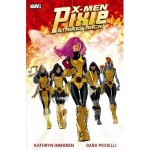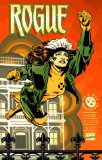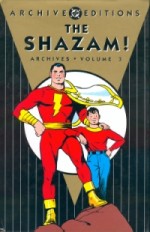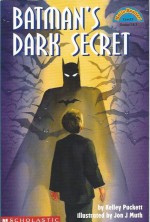
By Doug Moench, Chuck Dixon, Alan Grant, Jim Aparo, Norm Breyfogle, Graham Nolan, Jim Balent, Bret Blevins, Klaus Janson, Mike Manley & various (DC Comics)
ISBN: 978-1-78116-094-7
The early 1990s were troubled times for the American comicbook industry with speculative collectors rather than fans driving the business. Many new companies had established themselves using attention-catching gimmicks augmented by new print technology and outright pandering to sex and violence and the tactics had worked, sparking a glossy, four-colour Gold-Rush amongst fans and, more importantly, previously disinterested outsiders.
With vapid ploys and fleeting trends fuelling mass-multiple purchases by buyers who were too scared to even open up the hundreds of polybagged, technologically-enhanced variant-covered issues they intended to pay for college and a condo with, the major publishers were driven to design boldly bonkers stunts just to keep the attention of their once-devoted readership. At least here, however, story-content still held some worth and value…
In 1992 DC began their epic Death of Superman story-arc and clearly immediately afterward began preparing a similarly tradition-shaking, continuity-shattering epic for their other iconic household name property. Groundwork was already laid with the introduction of Jean-Paul Valley, a mild-mannered student utterly unaware that he had been programmed since birth by his father and an ancient warrior-cult to become an hereditary instrument of assassination (see Batman: Sword of Azrael) so all that was needed was to sort creative personnel and decide just how best to shake up the life of Gotham Guardian…
KnightFall and the subsequent KnightQuest and KnightsEnd, follow the tragic fall, replacement and inevitable return of Bruce Wayne as the indomitable, infallible Batman and was another, spectacular success from the old-guard which showed all the comicbook upstarts and Young Turks the true value of proper storytelling and the inescapable power of established characters, as the world was gripped by the Dark Knight’s horrific defeat at the hand’s of a superior foe.
The crossover publishing event impacted many comics outside the usual Batbook suspects, spawned a bunch of toys, three novelisations, many (necessarily incomplete) trade paperback collections and even jumped the pond to Britain’s staid BBC who turned it into a serialised audio-play on Radio One…
In 2012 DC finally began collecting the entire saga into three huge chronological compilations which, whilst still not truly complete, render the tale a far smoother readable experience for older fans and curious newcomers…
Batman: KnightFall volume 1, which could be best codified as and divided into ‘The Breaking of the Bat’ and ‘Who Rules the Night’, gathers the pertinent contents of Batman: Vengeance of Bane Special #1, Batman #491-500, Detective Comics #659-666, Showcase ’93 #7-8 & Batman: Shadow Of The Bat #16-18 – spanning January to October 1993 – and covers the most traumatic six months of Bruce Wayne’s adult life in instalments of a shared and progressing narrative alternating between Bat-titles.
What you won’t find out here: in the months preceding the start of KnightFall (roughly correlating to Batman issues #484-489 and Detective #654-658), a mysterious new criminal had covertly entered Gotham, discreetly observing the Caped Crimebuster at work as the hard-pressed hero tackled sinister crime-lord Black Mask, psycho-killer Metalhead and juvenile military genius The General, whilst foiling an assassination plot against Police Commissioner Jim Gordon.
On the edge of exhaustion, Wayne began seeing doctor and holistic therapist Shondra Kinsolving, whilst assigning Tim Drake – the third Robin – to training and monitoring Jean-Paul Valley, with the intention of turning the former Azrael‘s dark gifts to a beneficial purpose. Kinsolving was also treating Drake’s father, crippled after an attack by another of the City’s endless stream of criminal lunatics.
The cold observer Bane revealed himself and designed further tests for the depleted Dark Knight, challenging Batman for the right to rule Gotham, and manufacturing confrontations with Killer Croc and The Riddler, the latter augmented and driven crazy by a dose of deadly super-steroid Venom…
The action begins here with the origin of the challenger in ‘Vengeance of Bane’ by Chuck Dixon, Graham Nolan & Eduardo Barretto, wherein the hulking brute is fully revealed. Years ago on the Caribbean island of Santa Prisca, the ruling junta imprisoned the pregnant wife of a freedom fighter. When the baby was born he was sentenced in his father’s stead to life on the hellish prison rock of Pena Duro where he somehow thrived, touched by the horror and madness to become a terrifying, brilliant master of men.
Not merely surviving but educating himself and ultimately thriving on the hard medicine of life, the boy knew he had a destiny beyond those walls. Eventually he named himself Bane.
His only non-hostile contacts became his faithful lieutenants, Trogg, Zombie and the Americano Bird, whose tales of the Bat in Gotham City fired the eternal prisoner’s jealousy and imagination…
Santa Prisca’s entire economy is based on drug smuggling and Bane’s moment came when one of his periodic rages crippled thirty inmates. After finally being subdued by an army of guards he was turned over to scientists testing a new iteration of the muscle and aggression-enhancing formulation Venom. The effects of the steroid had caused the death of all previous candidates, but Bane survived and the delighted technologists devised biological implants that would deliver doses of the drug directly into his brain, enabling him to swiftly multiply his strength and speed at the press of a button…
A plan formed and the patient faked his own death. Disposed of as trash, he returned, seizing the Venom supply, rescuing his comrades and indulging in a fearsome vengeance against his oppressors. Then he turned greedy eyes towards Gotham and the only rival he could imagine…
KnightFall proper begins after Bane’s challenge to the already on-the-ropes Gotham Gangbuster with Batman #491 as ‘The Freedom of Madness’ by Doug Moench & Jim Aparo sees the ambitious strategist steal National Guard armaments and use them to break free every insane super-criminal locked away in Arkham Asylum. Pushed almost beyond rationality, Batman orders Robin to stick with his mission to train and de-program Jean-Paul and sets out to recapture all his most dangerous enemies, whilst Bane sits back, watching and waiting…
Issue #492 sees the round-up start with the Mad Hatter in ‘Crossed Eyes and Dotty Teas’ (Moench & Norm Breyfogle) and proves that even Bane can make mistakes, for whilst Batman acts according to plan and scotches the Hatter’s main party, the Mad Cap Maniac has already despatched a mind-controlled Film Freak to track down their mysterious liberator…
Detective Comics #659 opens with god-obsessed Maxie Zeus, innocuous Arnold Wesker and hyperthyroid brute Amygdala fleeing the broken Arkham in ‘Puppets’ (Dixon & Breyfogle) as Batman is called to the alley where the broken, lifeless body of Film Freak was found.
As The Ventriloquist, Wesker used the gangster doll Scarface to express his murderous schemes and with Amygdala now in tow has begun a lethal search to get back his old boss. The Dark Knight is obsessively locked on recapturing all his old enemies and ignores Robin’s pleas for rest and reason before tackling the hulking brute, but the confrontation does allow the cool-headed Boy Wonder to turn the tables on Bird, secretly following the Dynamic Duo for Bane.
However the Pena Duro inmate is too much for the apprentice adventurer and only Bane’s order stops Bird from killing the boy too soon. The chaos is building in Gotham and the master planner wants nothing to spoil his intricate schemes…
Moench & Breyfogle then contribute ‘Redslash’ in Batman #493 as knife-wielding maniac Victor Zsasz invades a girl’s school. The blood-soaked psycho marks each kill with a new scar on his own body and it’s been too long since his last, but by-the-book cop Lieutenant Stan Kitch‘s wait-and-see policy only results in two more deaths that Batman cannot scrub from his own over-worked conscience.
In the final confrontation patrolwoman Rene Montoya needs all her determination and utmost efforts to prevent the Dark Knight from beating Zsasz to death…
The chaos grows…
When they last met, Bane nearly crippled Killer Croc and the diseased carnival freak goes looking for payback in Detective #660, but his ‘Crocodile Tears’ (by Dixon, Jim Balent & Scott Hanna) lead Robin, still craftily tracking Bird and Bane, into a deadly trap in the City’s sewers whilst Batman #494’s ‘Night Terrors’ (Moench, Aparo & Tom Mandrake) finally sees the re-emergence of the Joker, having fun his way whilst looking for a partner to play with.
A collapsed tunnel saves Robin, but Bruce Wayne seems hell-bent on self-destruction, unable to relax until the maniacs are back behind padded bars.
Ignoring all pleas from Alfred and Tim, he heads out into the night and narrowly prevents Jim Gordon’s murder at the hands of illusion-casting cannibal Cornelius Stirk, but is unaware that the Clown Prince has allied with the Scarecrow and kidnapped Gotham Mayor Armand Krol…
In Detective #661 the Arkham Alumni terrorise Krol, forcing him to sabotage the city through emergency edicts whilst pyromaniac Garfield Lynns sets the ‘City on Fire’ (Dixon, Nolan & Hanna). Having allowed Robin to tag along, Batman allows the Boy Wonder to tackle the Firefly whilst he searches for less predictable prey. Meanwhile  Wesker is closing in on his Scarface and a recently de-venomed Riddler can’t pull off a robbery because there’s nobody around to answer his obsessively-constructed crime conundrums…
Barely breaking stride to take out the Cavalier, the Caped Crusader stumbles across the Firefly and almost dies at the hands of the relative lightweight in ‘Strange Bedfellows’ (Batman #495, Moench, Aparo & Bob Wiacek) as, impatient to help, Jean-Paul takes to the streets on his own, eager to help in a makeshift masked identity…
Finally convinced to take a night off, Bruce attends a civic gala and is recognised by Bane just as Poison Ivy turns up to kidnap all of Gotham’s glitterati. As Batman fights floral-based zombies, Gordon and his top aide Bullock lead the GCPD into a perfect ambush set by Scarecrow and the Joker…
Detective #662 sees Robin spectacularly if injudiciously tackle Riddler’s ‘Burning Questions’ (Dixon, Nolan & Hanna) as Batman at last ends Firefly’s horrific depredations, and unsanctioned vigilante The Huntress secretly joins the battle to stem the rising tide of chaos, after which Batman #496 begins the climactic clash between the completely exhausted Masked Manhunter and his maddest monsters in ‘Die Laughing’ (Moench, Aparo & Josef Rubinstein), as Scarecrow and Joker explosively seal off the Gotham River Tunnel with the broken Mayor at the bottom of it.
Only the detonation of the tunnel roof and a million gallons of ingressing river prevent Batman from beating the Harlequin of Hate to death, but Detective #663 proves there’s ‘No Rest for the Wicked’ (Dixon, Nolan & Hanna) as the hero frantically hauls Krol to safety, merely to fall victim to a concerted assault by Bane’s hit squad. Narrowly escaping, the harried hero heads home only to find Alfred unconscious and his home invaded by the orchestrator of all his woes…
Batman #497 presents the end of the road in ‘Broken Bat’ by Moench, Aparo & Dick Giordano as Bane finally attacks in person, mercilessly beating the exhausted but valiantly battling hero, ultimately breaking his spine in a savage demonstration of his physical and mental superiority.
Detective #664 sees the beginning of Bane’s Reign in ‘Who Rules the Night’ (Dixon, Nolan & Hanna) as the Scourge of Pena Duro drops the broken Batman’s body in the middle of Gotham and publicly declares himself the new boss. Even after Alfred and Robin intercept the ambulance carrying their shattered friend and mentor, saving his life proves a touch-and-go proposition and in the interval Joker and Scarecrow come to a parting of the ways and the Ventriloquist is reunited with his malevolent master Scarface. Gotham is a city at war and soon Boy Wonder and ex-Azrael are prowling the rooftops trying to stem the tide…
The tale diverges here to reveal the contents of Showcase ’93 #7 and 8, wherein Alfred, Robin and Jean-Paul restlessly wait by the comatose Wayne’s bedside, and traumatised Tim Drake recalls how mere days previously they thwarted the latest murder-spree of erstwhile Gotham DA Harvey Dent.
‘2-Face: Double Cross’ and the concluding ‘2-Face: Bad Judgment’ by Moench & Klaus Janson found the Double Desperado again challenging his one-time ally by setting up a hangman’s court in a confused and tragic attempt to convict Batman of causing all the former prosecutor’s problems…
Batman #498’s ‘Knights in Darkness’ (Moench, Aparo & Rick Burchett) saw the shattered remnant of Bruce Wayne regain consciousness as a paralysed paraplegic wreck, only to reveal an even greater loss: his fighting spirit. Faking a road crash to explain his massive injuries, Tim and Alfred consult blithely oblivious Dr. Kinsolving in an attempt to restore the billionaire’s shattered spirit and broken body, whilst Bane goes wild in the city, brutally consolidating his hold on all the various gangs and rackets.
To further his schemes and swiftly counter any stubborn opposition, the King of Gotham then recruits Catwoman as his personal thief and retrieval service…
And in Wayne Mansion, as Shondra begins her course of therapy – knowing full well her patient’s injuries were not caused by pranging a Porsche – Tim Drake carries out Bruce’s wishes and offers Jean-Paul the role and Mantle of Batman…
Gotham City is a criminal’s paradise with thugs big and small running riot now that the Dark Knight has been so publicly destroyed, but Detective #665 reveals ‘Lightning Changes’ (Dixon, Nolan & Giordano) as the new but still inexperienced Batman and Robin start wiping up the street scum and making them fear the night again, under strict instructions from Wayne to avoid major threats until they’re ready. Valley however, seems to be slowly coming unglued, happily using excessive force and chafing to test himself against Bane.
Meanwhile a demoralised and wheelchair-bound Bruce Wayne is becoming increasing dependent on Shondra. When he can’t find her, he wheels himself through the gardens to the adjoining house of Tim’s father Jack Drake in time to interrupt an abduction by masked gunmen. Despite his best efforts, he is unable to stop them taking Shondra and the elder Drake, whilst in Gotham the new Bat has overstepped his orders and determined to go after Bane – even if it means allying with gangsters and risking the lives of innocent children…
One final diversion comes next in a sidebar tale from Shadow of the Bat #16-18 wherein Alan Grant, Bret Blevins, Mike Manley & Steve George describe how the sinister Scarecrow returns to his old college life long enough to turn innocent students into his phobic slaves as part of a grandiose and clearly crazy plan to turn himself into ‘The God of Fear’…
Juvenile ideologue and criminal genius Anarky escapes prison just in time to see “Batman†facing off against his first fully deranged super-villain and realises that the Dark Knight is a much a threat to the people as the Tatterdemalion of Terror. The young rebel decides that for the good of the common man he should take them both out…
It doesn’t quite work out that way, but after Scarecrow exposes Batman to his fear gas and it doesn’t work, they combine to vanquish the failed deity. Valley, in an increasingly rare moment of rationality, lets Anarky off with a pretty scary warning. The former Azrael muses on how his programming had made him immune to the fear chemicals, but he couldn’t be more wrong…
The Beginning of the End starts in Batman #499 with ‘The Venom Connection’ by Moench, Aparo & Hanna, as the replacement’s ruthless savagery and burgeoning paranoia drives a wedge between him and Robin, whilst oblivious to it all, the rededicated and driven Bruce Wayne uses the sleuthing skills of a lifetime to trace the kidnappers to Santa Prisca…
In the Batcave, Jean-Paul realises he is still subject to the deep programming that created Azrael when he falls into a trance and awakens to find he has designed deadly new high-tech gauntlets to augment his war on crime. Bane, meanwhile, ignores all entreaties to act, refusing to bother with a mere impostor.
In a blistering raid, Batman and Robin capture Bane’s lieutenants, although the Darker Knight coldly risks children’s lives to achieve victory. Alienated and deeply troubled, Tim determines to tell Bruce but finds the Mansion deserted, Bruce and Alfred having left for the Caribbean, unaware that they have a svelte stowaway in the form of Catwoman Selina Kyle…
Detective #666 pushes things to fever-pitch with ‘The Devil You Know’ (Dixon, Nolan & Hanna) as the augmented, ever-angry and clearly losing it Batman breaks Trogg, Bird and Zombie out of jail and follows them back to Bane, only to fall before the blockbusting power and ferocity of the Venom-addicted living juggernaut…
Batman #500 is divided into a landmark two-part conclusion. ‘Dark Angel 1: the Fall’ by Moench, Aparo & Terry Austin, sees Batman frantically escape certain death at Bane’s hands and retreat to the Batcave where the Azrael’s submerged programming – dubbed “the System†– takes temporary control and devises a perfectly honed technological suit of armour that turns Batman into a human war-machine. Far more worrying is the rift that drives Robin, Nightwing and every other possible ally away as Valley prepares for his final confrontation with Bane…
The infuriated King of the City wants it too and challenges the impostor to a very visible duel in the centre of Gotham in ‘Dark Angel 2: the Descent’ (illustrated by Mike Manley), a blockbusting battle which comprehensively crushes Bane and publicly proclaims the return of a new, darker Champion of the Night. As Batman narrowly chooses to leave Bane a crushed and humiliated living trophy rather than dead example, Robin – who had to save a train full of innocent bystanders from becoming collateral casualties of Batman, not Bane – realises something very bad has come to Gotham…
To Be Continued…
There’s something particularly enticing about these colossal mega-compilations (this one’s 640 pulse-pounding pages) that sheerly delights the 10-year old in me: proven, familiar favourite stories in a huge, wrist-numbing package offering a vast hit of full-colour funnybook action, suspense and solid entertainment. There’s also a superb gallery of covers from Glenn Fabry, Kelly Jones, Sam Kieth, Bill Sienkiewicz, Brian Stelfreeze, Joe Quesada & Kevin Nowlan and Mike Deodato Jr. and even tantalising ads for other books you just gotta have!
Just like this one…
© 1993, 2012 DC Comics. All Rights Reserved.








